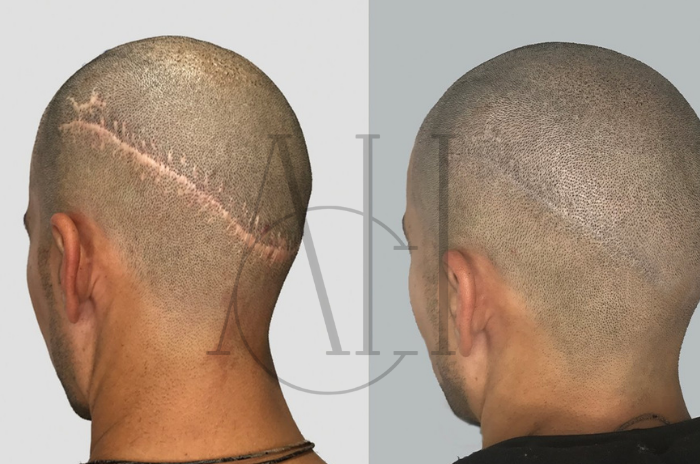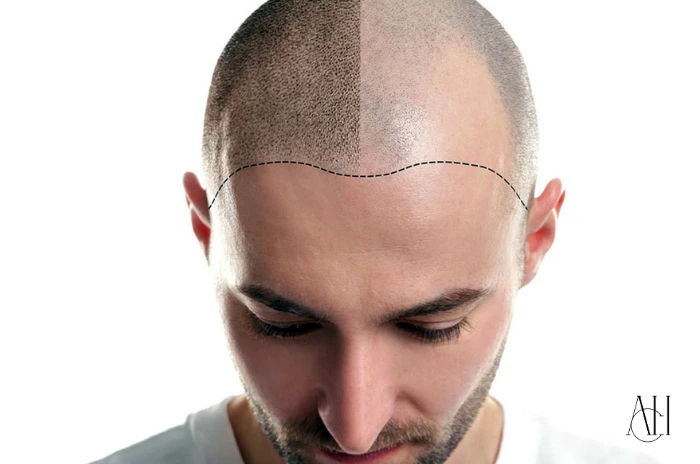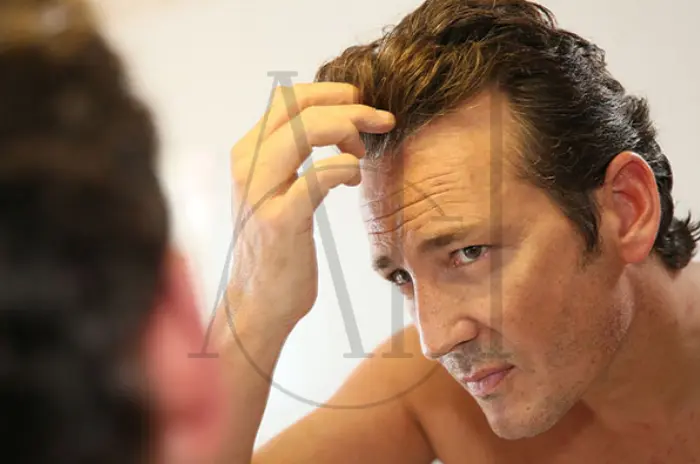Scalp micropigmentation (SMP) is a revolutionary non-surgical hair restoration method designed to create the illusion of fuller hair. It involves applying specialized pigment to the scalp to mimic the appearance of tiny hair follicles. For those struggling with hair loss, especially male pattern hair loss and hair loss in women, SMP offers a modern solution with realistic and immediate results. It requires no donor hair and provides an instant visual improvement. This makes it a practical choice for many individuals looking for low-risk alternatives.
Table of Contents
ToggleWhat Is Scalp Micropigmentation?
Scalp micropigmentation is a cosmetic procedure that involves depositing natural pigment into the scalp’s dermal layer. This technique replicates the look of real hair follicles and creates a shaved-head or denser-hair appearance. It is often considered a form of medical tattooing with a highly specialized technique. Unlike traditional tattoos, SMP uses precise equipment and pigments tailored for the scalp.
How Does Scalp Micropigmentation Address Hair Loss?
By targeting the visible signs of hair loss, SMP offers a quick aesthetic solution. It creates the illusion of thickness for long hair, enhances the hairline, or camouflages bald spots and scars. The procedure visually reduces contrast between the hair and the scalp, which helps improve confidence. It is particularly effective in advanced stages of thinning where traditional treatments may fail.
Who is Scalp Micropigmentation For?
-
Individuals with male pattern hair loss or female pattern hair loss
-
People with alopecia
-
Patients with scalp scars or birthmarks
-
Those who want to enhance their hairline
-
Individuals seeking a non-surgical hair restoration alternative
-
People who cannot undergo surgical hair procedures due to medical reasons
-
Individuals looking for a low-maintenance aesthetic solution
Does Scalp Micropigmentation Grow Hair?
No, scalp micropigmentation does not grow back lost hair. It only creates a visual illusion of hair density. There is no biological stimulation of follicles involved. However, it can effectively improve the appearance of thin or bald areas.
What Causes Hair Loss?
1. Alopecia Areata
An autoimmune condition where the immune system attacks hair follicles, leading to patchy hair loss. It can occur suddenly and affect any hair-bearing area. SMP can help mask the affected areas effectively. It provides a confidence boost during unpredictable hair regrowth cycles.
2. Chemotherapy-Related Hair Loss
Hair falls out due to the effects of chemotherapy drugs, which target rapidly growing cells. This type of hair loss is often temporary but distressing. SMP can offer an interim visual solution until natural regrowth occurs. It is especially helpful for patients who want to maintain a sense of normalcy.
3. Female Pattern Hair Loss
A genetic condition causing thinning across the scalp, usually maintaining the frontal hairline. It is a common but emotionally taxing condition. SMP can fill in sparse areas to make hair look fuller. It also complements topical or oral hair loss treatments.
4. Male Pattern Hair Loss
Characterized by a receding hairline and thinning at the crown, it’s the most common type of hair loss in men. It typically follows a predictable pattern over time. SMP can recreate the look of a full buzz cut. Many men choose it as a low-commitment alternative to surgery.
5. Scars or Birthmarks on the Scalp
Scarring from injury or surgery can lead to permanent hair loss in that area, which SMP can effectively cover. SMP blends the pigment with surrounding hair for a seamless look. It also helps reduce self-consciousness associated with visible marks. This makes it valuable post-transplant or post-trauma.

Scalp Micropigmentation Pros and Cons
This section outlines the advantages and disadvantages of SMP:
Pros:
-
Realistic look
-
Minimal downtime
-
Cost-effective
-
Low maintenance
-
Works for many hairstyles
-
Suitable for different hair colors and skin tones
-
Results visible almost immediately
Cons:
-
Doesn’t grow back lost hair
-
Requires shaving in most cases
-
Can be uncomfortable
-
Difficult to remove or modify
-
Not suitable for those seeking long hairstyles
-
May need touch-ups over time
What Can You Expect With Micropigmentation?
During treatment, a specialist applies pigment using micro-needles. The process takes 2-3 sessions for optimal results. Each session typically lasts 2 to 4 hours depending on the area. Color may appear darker at first but fades to a natural tone within days.
What Can You Expect After Scalp Micropigmentation?
You may experience slight redness or tenderness for 1-2 days. The pigment will settle over a few weeks, and touch-up sessions may be required. Most patients can resume work the next day. Full aftercare includes avoiding water exposure, sweating, and sun for several days.
Is Scalp Micropigmentation Safe?
Yes, SMP is medically safe when performed by trained professionals. It uses hypoallergenic pigments and sterile equipment. Proper technique ensures pigment placement stays consistent over time. Always verify the technician’s qualifications before proceeding.
Advantages of Scalp Micropigmentation
1. Scalp Micropigmentation Looks Real
The appearance of a full head of shaved hair or denser thinning hair is convincingly natural. The pigments match your skin and hair tone precisely. This realistic effect is a key reason many prefer SMP. It blends well even on close inspection.
2. Short Recovery Time
Most patients return to normal activity within 24-48 hours. Redness usually subsides within one day. There are no stitches or incisions involved. This allows for minimal disruption to daily life.
3. SMP Works for Practically Every Hairstyle
Bald, buzzed, or long hair styles all benefit visually from SMP. It adds perceived density and symmetry. SMP is versatile enough to enhance nearly any look. That makes it a fit for men and women alike.
4. Scalp Micropigmentation is Safe
With proper hygiene and aftercare, the procedure has a very low complication rate. Most clients report no major side effects. Reputable clinics use approved and skin-safe pigments. Infection risk is extremely low under sterile conditions.
5. Low Maintenance
No special shampoos or daily applications are needed. Just follow the technician’s aftercare guide. Occasional touch-ups every few years are all that’s needed. This simplicity appeals to many clients.
6. Less Pain
Compared to other cosmetic procedures, SMP causes less discomfort. Most describe the sensation as light scratching. Numbing agents may be applied to enhance comfort. Pain is rarely a barrier to treatment.
7. Cost-Effective
SMP is significantly more affordable than a hair transplant. It involves no surgery or recovery medications. The results last years with minimal upkeep. This makes it a practical long-term investment.

Disadvantages of Scalp Micropigmentation
1. There Are Some Bad SMP Artists Out There
Poor technique can lead to unnatural results or uneven pigment. Always research before choosing a provider. Look at before-and-after galleries. Certification and experience matter.
2. If You No Longer Want SMP, Removing It Can Be a Pain
Laser removal is possible but costly and time-consuming. It may require multiple sessions. The process can be uncomfortable and leave scars. This is why initial planning is crucial.
3. It’s More Difficult to Change Up Your Look
Once applied, the style is semi-permanent. It limits hairstyles that require visible scalp changes. Consider your future style goals before choosing SMP. Planning ensures long-term satisfaction.
4. You Will Need to Shave
To maintain a natural appearance, regular scalp shaving may be necessary. This keeps the illusion consistent. For some, this may not be desirable or feasible. Alternative options may be better for longer hairstyles.
5. Not a Permanent Solution
Although long-lasting, it may fade over time and need touch-ups. Sun exposure and skin type affect fading. Maintenance every 3–6 years is common. Still, it’s more stable than most cosmetic treatments.
6. Doesn’t Grow Back Lost Hair
It’s purely cosmetic and not a treatment for follicle regeneration. SMP won’t help hair growth at a biological level. Other treatments may be combined for regrowth. SMP is a visual, not clinical, solution.
7. The Procedure Can Be a Bit Uncomfortable
While less painful than a tattoo, it can still cause some discomfort. Some areas of the scalp are more sensitive. Most people tolerate it well with minimal issues. Pain relief options can be discussed in advance.
What Are the Risks or Complications of This Procedure?
-
Infection from unsterile equipment
-
Allergic reactions to pigment
-
Uneven or fading color if aftercare is ignored
-
Rare pigment migration under the skin
-
Temporary redness and sensitivity
-
Dissatisfaction with final appearance due to poor technique
Scalp Micropigmentation: Is It Worth It?
For those seeking a quick, low-maintenance solution to hair loss, SMP is an excellent option. It’s especially useful for individuals who are not suitable candidates for hair transplant or prefer non-surgical hair restoration. The immediate aesthetic improvement can boost self-esteem. SMP delivers consistent results when performed by experienced practitioners.
Does Scalp Micropigmentation Look Real?
Yes, when done correctly, it creates the illusion of real hair follicles. The result is highly convincing and undetectable to most observers. SMP mimics natural hair growth patterns. Proper shading and depth make all the difference.
How Long Does Scalp Micropigmentation Last?
SMP typically lasts 4-6 years before noticeable fading. SMP touch-up frequency depends on skin type, sun exposure, and lifestyle. Some may need refreshers sooner than others. Proper aftercare can extend longevity.
Does Scalp Micropigmentation Grow Hair?
No. SMP is not a hair loss treatment and doesn’t regrow hair. It only simulates hair density visually. Other medical options may be explored for regrowth. SMP enhances appearance without affecting hair biology.
What’s the Difference Between Micropigmentation and a Hair Transplant?
A hair transplant moves real hair follicles to thinning areas. Scalp micropigmentation, in contrast, uses pigment to mimic the look of hair without stimulating growth. One is surgical, the other cosmetic. They may be used together for optimal results.
What Is the Recovery Time After Scalp Micropigmentation?
Recovery is typically 2-5 days. Full healing and pigment settling may take up to 3 weeks. Most patients return to daily routines quickly. Avoiding sun and moisture during healing is essential.
Quick Comparison Table: SMP vs. Hair Transplant
| Feature | Scalp Micropigmentation (SMP) | Hair Transplant |
|---|---|---|
| Invasiveness | Non-surgical | Surgical |
| Downtime | 2-5 days | 7-14 days |
| Hair Regrowth | No | Yes |
| Maintenance | Low | Medium |
| Cost | Moderate | High |
| Pain Level | Mild | Moderate to high |
| Suitable for Alopecia | Yes | Sometimes |
FAQ for Scalp Micropigmentation (SMP): Pros, Cons & Realistic Results Explained
What is scalp micropigmentation (SMP)?
It is a cosmetic procedure that implants pigment into the scalp to mimic the appearance of hair follicles. The goal is to create a natural-looking shaved hair or hair density illusion.
Who is an ideal candidate for scalp micropigmentation
Anyone with hair loss, alopecia, thinning hair, or scalp scars is a good candidate. It’s suitable for both men and women. Those with medical conditions precluding surgery may also benefit.
Does scalp micropigmentation stimulate hair growth?
No, it only gives the appearance of fuller hair. It doesn’t promote hair regrowth.
What are the advantages of scalp micropigmentation?
It’s realistic, low maintenance, and cost-effective compared to other treatments. It offers immediate results after a few sessions.
What are the potential drawbacks of scalp micropigmentation?
It doesn’t grow hair, and removing it can be difficult. It may also limit hairstyle flexibility.
How long does scalp micropigmentation last?
Results usually last 4-6 years with proper care. Touch-ups may be needed to maintain the look. Lifestyle and skin type affect longevity.
Is scalp micropigmentation safe?
Yes, especially when performed by trained professionals using sterile tools and quality pigments.
How does scalp micropigmentation differ from a hair transplant?
MP is non-surgical and cosmetic; a hair transplant relocates actual follicles for real growth.




